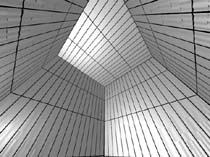












 |
Woody Vasulka- artist |
|
|
What kind of role pictures play in your professional field? |
|
I have always looked at my images as artefacts |
I don’t know if you got the right question because I stopped relating to images about 12 years ago.
|
Do you see a relation between poetry and working poetically with code? |
|
“a drowning in the moment”: a transcendental shift from the sequence of words to the abstraction of the poetic essence |
In an assumption, let me say that poetry has its own code. If you have a look at paintings and poetry, the painting often looks like a prescription to the poetry, but it is not poetry. Poetry happens in your mind where it lives as a very tightly guarded closed system. Poetry is an indefinable object, it doesn’t have its physical existence. A sound of a voice can bring its dominant features to the poetry and then perhaps even change the character or the content itself. Of course it mostly reaches us as a written text and everybody has to change the text to an inner or oratory voice. Although the poetry is coded in words, the mind evokes its essential form of a transition, experienced. The best description to this miracle I found in my early days was in the words of a Czech literate where he describes it as “a drowning in the moment”, in the Czech language simple three words, but they break the barrier of poetics on its own, sounding ominous, ultimate and terminal.
|
You mentioned your pictorial discovery by photography. Do you see a difference between the mechanical image processing of photography and the computer based imaging process? |
|
What we call the Imperial View of the camera has impregnated our consciousness, perpetuating clichés about what our world is. |
There are all kinds of photography. The camera photography usually deals with the pinhole principle extended into the lens arrangement. Once the camera captures the world and captivates the world’s attention, people got completely mesmerized by the moving image. Our perception agrees so much with this illusion of apparent motion, suggested by the film apparatus that humankind has accepted this abstract cinematic space as its own. What we call the Imperial View of the camera has impregnated our consciousness, perpetuating clichés about what our world is.
|
What about the digital techniques? |
|
the digital code began to sweep away the traditional image and sound making |
In the second half of the seventies we spent all our time building digital tools and learning the code. Here was another mystery to break into. At the beginning of the eighties, it was over. The digital world had arrived.
|
How did you benefit from the digital experience? |
|
The question of Microesthetics: What happens between two frames? |
To say it dramatically, I suddenly understood the banal truth of the method by which the technology gains and occupies the time/space. By the action of chopping time into smaller and smaller divisions, each provides just the tiniest moment for its desired activity: changing a logical state of the machine. Underneath there is a whole poetic principle in a single question: what happens between the frames or better yet, what happens between two frames? Actually I call this question a question of Microesthetics. |
What about mathematics in computer based imaging? |
|
Once you touch the code you are entering a specific garden of varieties, because code can be in a continuous transformation, the computer has an infinite ability to make variations. |
There are two major components of a digital computer: the Central Processing Unit, CPU, and the Arithmetic Logic Unit, ALU. Of course it is the logic state that runs the machine: But it is not really the numbers as we know them, once they are about to leave the machine they get re-coded, to mean something to us. We people communicate through numbers we have invented. Then other devices can do other code exchanges, numbers for letters, colour, voices and music and finally the images in an illusion of reality, representing the world or other worlds in an unmatched familiarity. Once you touch the code you are entering a specific garden of varieties, because code can be in a continuous transformation, the computer has an infinite ability to make variations. It is the same material for sound, image, colour and movement, subjected to some kind of logical transformations that are made to move the logical states of the machine. In that case it is the world that you emulate by strategies like the Renaissance perspective space made through electro-mechanical devices. Then each point on the screen is subjected to the transformation of Renaissance Perspective algorithm on an XYZ matrix. |
What about the abstraction that implicates the use of mathematics: It is fascinating how omnipotent mathematics become by the process of formalisation. But what is the price we pay for? |
|
algorithms as untouchable area: You can’t open a box to modify it and thereby change the image |
Mathematics are magical, no doubt about it, and not totally impenetrable, even young children can make use of it. It is that kind of empirical status of mathematics which is so powerful, even in simple mathematics like a number +1. But algorithms also constitute an untouchable area. You can’t open a box to modify it and thereby change the image, like we used to do in video. So it becomes the domain of a different hierarchy, the hierarchy of the software. You can no longer physically touch this kind of an art object. |
As technical process image production became a collaborative process. Arts and music still have a strong component of authorship. How do you behave as an artist? |
|
The computer is such an attack on everything.
 "study" from 1993 |
I was exposed to that very early. As a Czech, I come from a very long tradition of Bohemian art appreciation. I was a part of the radical generation emerging in the sixties. We instinctively looked at the system, replacing it with something personal or generational. This prescription comes from the late modern movement. But the war in a certain way interrupted this, because the war became more surrealistic than the surrealists. So this value of art diminished a bit.
|
Isn’t there a difference in acceptance of a medium how artists look at electronic images and musicians at electronic music? |
|
Jazz has challenged every intellectual discipline: the phenomenal idea of improvisation and a social environment that unlike notated music can never be re-enacted. |
The last century produced large quantities of that kind of electronic music, but that music seems to have disappeared. Even now when I try to listen to the radio, there is no way to get to hear a Xennakis, not even once a week. It is regretful and I believe that the electronic music and film were a fantastic contribution to the 20th century art. But there was also Jazz, one of the most sophisticated forms of music. In spite of being originally folk music, Jazz has challenged every intellectual discipline. There was this phenomenal idea of improvisation with quality, depth, technique, improvisation and a social environment that unlike notated music can never be re-enacted. I see Jazz as an extraordinary contribution to the modern movement in the last century, which was the experimental century with an astonishing future. |
We talked about content that can be transformed in all different kind of media. Do you also see formal parallels between images and music? |
|
In an acoustic time space you can’t really analyze what is happening in a frame. |
Between Steina and me, we use the word sound instead of music. When you make video audible the material is sound. Above all, in an acoustic time space you can’t really analyze what is happening in a frame. Every frame is superimposed by the next and you can only read the envelope.
|
What about synaesthetics fusing senses? |
|
The idea of uniting audiovisual aesthetics is so obsolete. |
The idea of unification, of uniting audiovisual aesthetics is so much at hand, yet so untouchable and unusable. But every new generation gets tempted. Since antiquity the idea of aesthetic translation working with or against the other has been repeated. You can eventually come to some sort of polyphony or contrapoint of colour, sound and rhythm, like the simplistic idea of Skriabins colour organ. But the audio world is so developed, it has no use for such kind of stuffs – it is so obsolete.
|
Did the quality of images change in the web? |
|
moving image as a system of syntax: how the proceeding connects to the succeeding – that is the threshold of my interest. |
They are no longer really images. They don’t even have the desire to be symbolic. In the western hemisphere, images are perceived as iconic or symbolic signs. I learnt that in the orient it is not the case. They don’t have a Madonna or a Christ with their hierarchy of symbols behind them. Therefore Paik's idea that images are like tones where you can use images like musical collages is crazy, because western people look for a symbolic meaning in an image intending to deconstruct it.
|
How do you see the relation of man and machine? |
|
a peculiarly intimate moment - when the machine gives the code to the human consciousness, |
The worlds of machine and mind enter into a dialog for a split moment. This is the moment when the machine gives the code to the human consciousness, a peculiarly intimate moment. I am not really talking about the roll in preparation of the image by the agent interested in applying the strategy of persuasion or information, I am talking about images contained and mediated under a different strategy, of unknown purpose and unknown principle in an abstract form, perhaps only understandable to an alien.
|
This is media art – what about art images in general? |
|
What fascinates me is how much we do live with images that we don’t really respect or focus on. |
What fascinates me is how much we do live with images that we don’t really respect or focus on.
|
What is your favourite image at home? |
|
I never hung one picture on my wall. |
It is very hard to say. At the moment El Greco is an interesting painter for me. Recently I found a book and re-discovered certain civic tendencies well beyond the religious and royal themes of his work I knew from before. But this re-visitation will go away making room for a next revelation. I know about pictures. But I keep them very much away from my live. I never hung one picture on my wall. But I can keep a sculpture around me like a mechanical or rubber thing.
|
interview by Tim Otto Roth from 1st March 2005 at ZKM Karlsruhe |
|
Links for Woody Vasulka:
|
|



